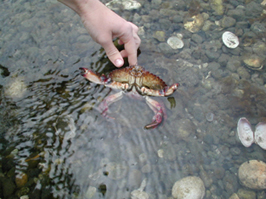What Do Most Sessile Animals Eat? (1 Sentence)
Some feeding behaviors observed at Argyle Creek are more obvious than others, because many of the animals are sessile and/or benthic. The majority of the animals observed were herbivores, carnivores, eolith feeders or suspension feeders. Because many of the organisms are sessile, they rely on transport of food by water currents. Many of the sessile organisms are filter feeders, feeding on plankton and other suspended material, while deposit feeders feed on detritus, herbivores on algae, and carnivores on other animals living in the creek.
Herbivores
The about abundant herbivores are chitons, which feed primarily on microscopic algae. These molluscs crawl with the assistance of mucus over rocks or bivalves, feeding on the algal pic growing on the surfaces. A chiton feeds by scraping the surface with a radula, a structure with difficult chitinous teeth that rasps food into the mouth. The radula is a defining characteristic of molluscs, although it has been lost evolutionarily in certain groups. Limpets, which feed a similar style, were also commonly establish on all surfaces of the uppermost rocks in the creek.

Suspension Feeders
Pause feeders rely on detritus and plankton. The appendages and mechanisms used to capture food vary among organisms. Filter feeding is one type of interruption feeding where small particles are removed from the h2o electric current and sorted by a filter. Bivalves such equally mussels, clams, scallops and oysters are filter feeders. Clams that burrow, and are therefore out of attain of most suspended textile, utilise a siphon that protrudes out of the basis and brings water down to a gear up of filters within the shell.
Annelid worms institute at Argyle, such as serpulids, spirorbids, and terebellids, are also suspension feeders. Serpulids and spirorbids are worms that live inside difficult, calcium carbonate tubes. The tubes are fastened to the surface of rocks, shells or algae that remain submerged underwater. When feeding, these animals project tentacled structures out of the tube to catch food particles in the flowing water. Past using cilia on their tentacles, these worms select particles based on size.

Barnacles are also extremely abundant at Argyle creek, found on rocks and on the shells of bivalves. Barnacles use their six pairs of articulated legs, known as cirri, for food capture. The cirri, which collect particles using a waving and gripping motion, are protruded and retracted through two movable plates at the top of the beat. Each co-operative of the legs has many setae to help in food capture. Barnacles are not specially selective filter feeders and are considered scavengers considering they feed on dead affair equally well.

Deposit Feeders
Deposit feeders usually feed past consuming sediment and digesting the organic fabric from the surfaces of the sediment. Terebellids, known equally spaghetti worms, are sedentary burrowers that accept specialized tentacles on their head used for feeding. The tentacles snake out over a surface to collect sediment particles, which are transported along ciliated grooves back to the mouth.
Carnivores
Carnivorous animals feed on other animals. This was the to the lowest degree common method of feeding at Argyle. Whelks and oysters, with the apply of their radula and secretions from a gland in their pes, bore holes through the shells of their mollusc prey and eat the viscera. Though non very common at Argyle, a few nudibranchs (bounding main slugs) were constitute, specifically the small nudibranch Aeolidia papillosa, which feeds on sea anemones (encounter Floats projection).

Multiple Feeding Methods
Crustaceans use a combination of feeding methods, including detritivory, filter feeding, and predation. Venereal take a pair of appendages modified into "pincher like" structures called chelae used to capture and seize their food. Past the use of setae on certain appendages, nutrient is captured and so brought to the oral cavity by other appendages. Crabs likewise have specialized oral fissure parts to help with ingesting food. Because their claws are modified with chelae, they can be predatory animals feeding mostly on chordates. Crabs are also suspension feeders that eat floating detritus. At Argyle we observed instances where more than than i crab was competing for the same bivalve. Thus, chelae may be involved in feeding, contest, and protection.
References:
- Ruppert, E.E. and Barnes, R.B. Invertebrate Zoology.6th ed. Saunders College Publishing, New York, 1975.
- Pandian, T.J. and Vernberg, F. Animal Energetics: Volume 1: Protozoa through Insecta. Bookish Press, Inc. New York, 1987.
- Jennings, J.B. Feeding, Digestion and Asimiliation in Animals. Macmillan St. Martin's Press, London, 1972.
Source: https://depts.washington.edu/fhl/zoo432/argyle/feeding.htm#:~:text=Many%20of%20the%20sessile%20organisms,animals%20living%20in%20the%20creek.
Posted by: clarkgothis.blogspot.com

0 Response to "What Do Most Sessile Animals Eat? (1 Sentence)"
Post a Comment